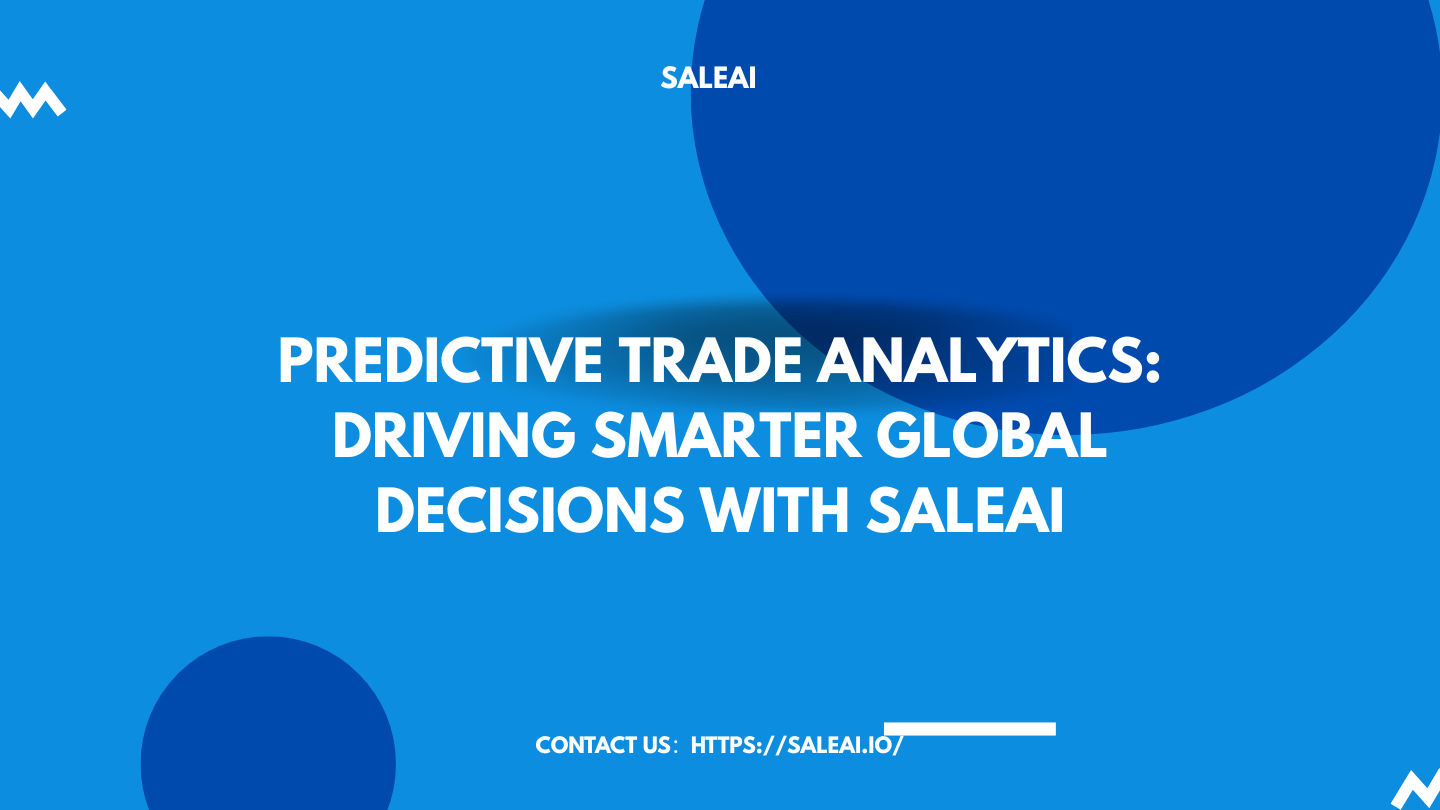Introduction: The Future is Predictive
In the fast-evolving global trade landscape, staying ahead of market trends is no longer a luxury—it’s a necessity. Businesses that rely on reactive decision-making often find themselves outpaced by competitors who harness the power of predictive analytics.
Predictive Trade Analytics, powered by SaleAI, is transforming the way companies approach global trade. By analyzing historical data, market dynamics, and real-time trends, predictive analytics offers actionable insights into future opportunities and risks. This allows businesses to anticipate changes, optimize operations, and maintain a competitive edge.
In this article, we’ll explore how Predictive Trade Analytics works, its core features, and the value it delivers to businesses navigating the complexities of international trade.
What is Predictive Trade Analytics?
Predictive Trade Analytics uses advanced AI algorithms and machine learning models to analyze large datasets and forecast future trade scenarios. By identifying patterns and trends in historical and real-time data, predictive analytics enables businesses to:
- Anticipate Market Demand: Understand upcoming shifts in product demand across regions and industries.
- Optimize Pricing Strategies: Forecast price trends and adjust pricing to maximize profitability.
- Mitigate Risks: Identify potential risks and disruptions in supply chains before they occur.
- Enhance Decision-Making: Provide data-driven recommendations for market entry, sourcing, and distribution.
Unlike static data analysis, predictive analytics focuses on forward-looking insights, helping businesses prepare for what’s next.
Key Features of SaleAI’s Predictive Trade Analytics
a. Demand Forecasting
One of the most valuable aspects of predictive analytics is its ability to anticipate future demand. SaleAI provides:
- Region-Specific Demand Predictions: Understand which products will be in high demand in specific markets.
- Seasonal Trends Analysis: Forecast how demand fluctuates during different times of the year.
- Emerging Market Signals: Identify new regions with growing demand for your offerings.
By leveraging these insights, businesses can adjust production, inventory, and marketing strategies to align with future demand.
b. Pricing Optimization
Predictive analytics helps businesses stay competitive by forecasting pricing trends. SaleAI offers:
- Price Benchmarking: Compare pricing strategies against competitors to identify opportunities for adjustment.
- Dynamic Pricing Recommendations: Receive AI-driven suggestions for optimal pricing based on market conditions.
- Profit Margin Analysis: Analyze how pricing changes impact profitability and overall revenue.
With pricing optimization, businesses can balance competitiveness with profitability, ensuring long-term success.
c. Supply Chain Disruption Alerts
Global supply chains are increasingly susceptible to disruptions, from geopolitical events to natural disasters. SaleAI’s predictive tools help businesses:
- Monitor Risk Factors: Track potential disruptions in key trade routes or sourcing regions.
- Develop Contingency Plans: Use predictive insights to prepare alternative sourcing or logistics strategies.
- Minimize Operational Downtime: Anticipate and address supply chain disruptions before they escalate.
These features allow businesses to maintain operational stability even in unpredictable environments.
d. Competitor Activity Projections
Understanding competitors’ strategies is crucial for staying ahead. SaleAI’s predictive analytics provides:
- Competitor Trend Analysis: Forecast competitors’ sourcing, pricing, and distribution strategies.
- Market Share Predictions: Estimate how competitor activities will impact your market position.
- Strategic Insights: Identify gaps in competitors’ strategies that you can exploit.
By anticipating competitor moves, businesses can refine their strategies and maintain a competitive edge.
How Predictive Trade Analytics Benefits Businesses
a. Proactive Decision-Making
Predictive analytics shifts the focus from reacting to market changes to proactively preparing for them. This allows businesses to capitalize on opportunities and mitigate risks before they materialize.
b. Improved Resource Allocation
By forecasting demand, pricing, and risks, businesses can allocate resources more effectively, reducing waste and maximizing ROI.
c. Enhanced Customer Satisfaction
Meeting future demand with the right products at the right price ensures customers receive what they need when they need it, improving satisfaction and loyalty.
d. Competitive Advantage
Businesses that leverage predictive analytics gain a strategic edge by staying ahead of competitors and adapting to market changes faster.
Practical Use Cases of Predictive Trade Analytics
a. Inventory Management for Exporters
An exporter uses SaleAI’s predictive analytics to forecast demand for consumer electronics in Southeast Asia. By aligning production with anticipated demand, they reduce inventory costs while meeting market needs.
b. Dynamic Pricing for Manufacturers
A global manufacturer leverages predictive pricing tools to adjust their pricing strategy for automotive parts in response to market fluctuations. This enables them to stay competitive while maintaining healthy profit margins.
c. Supply Chain Risk Mitigation for Retailers
A global retail chain uses predictive analytics to monitor potential disruptions in their supplier network. When a disruption is forecasted, they activate alternative sourcing plans, ensuring uninterrupted operations.
d. Competitor Strategy Analysis for B2B Companies
A B2B foreign trade company uses predictive tools to analyze competitors’ sourcing strategies. They identify gaps in competitors’ supply chains and secure exclusive agreements with key suppliers to gain an edge.
Why Choose SaleAI for Predictive Trade Analytics?
- AI-Driven Precision: Advanced algorithms analyze billions of data points to deliver accurate forecasts.
- Comprehensive Data Coverage: Access trade data, competitor insights, and market trends from over 130 countries.
- Real-Time Updates: Stay informed with continuously updated predictions based on the latest data.
- Actionable Insights: Receive clear, data-backed recommendations for immediate implementation.
- Proven Expertise: With over 6,000 global clients, SaleAI is a trusted leader in trade intelligence and analytics.
How to Get Started with SaleAI’s Predictive Trade Analytics
- Define Your Objectives: Identify the key areas where predictive analytics can add value, such as demand forecasting or risk mitigation.
- Access the Platform: Use SaleAI’s intuitive interface to explore predictive insights tailored to your needs.
- Leverage AI Recommendations: Apply the insights to refine your strategies and make data-driven decisions.
- Monitor Performance: Track outcomes and adjust strategies as new predictions become available.
With SaleAI, predictive analytics becomes an integral part of your decision-making process, driving growth and success.
Conclusion: Empower Your Business with Predictive Trade Analytics
In today’s dynamic global trade environment, relying on historical data alone is no longer enough. Predictive Trade Analytics by SaleAI empowers businesses to look ahead, anticipate changes, and act decisively.
From forecasting demand to optimizing pricing and mitigating risks, predictive analytics provides the tools you need to navigate uncertainty and seize opportunities.
Stay ahead of the curve—partner with SaleAI and transform the way you approach global trade with predictive analytics.





